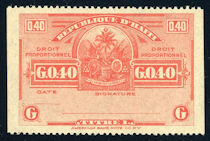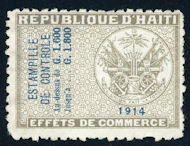Haitian Revenues
Revenue Paper & Adhesive Stamps
Collectors of Haitian revenue material find that they have a wealth of markings and revenue stamps to pursue. Many of the items are exceedingly scarce as they were not offered to collectors, but were used to show fees paid to the government for certain transactions. The taxes collected, as represented by these items, were generally used to fund Government programs and in more modern times, they have built stadiums, airports, funded various national programs, and provided other services.
If you are beginning a collection of this area of Haitian philately, we believe you will find the information below to be most useful. More in-depth information has been published on the subject in Haiti Philately and elsewhere in the philatelic press.
Revenue Paper (Hand Stamped)
Although Haiti declared its independence from France on January 1, 1804, we know that several of the pre-Independence tax laws enacted by the French were still being applied post-1804. In the passage of Haiti's own first tax law of 1807, reference is made to at least three French laws (two in 1791; one in 1795) that had bearing on Haiti's revenue system from circa 1804 to circa 1817.
When consulting Haiti's revenue laws, those laws generally, but not always, are divided into two sections; namely, one describing the tax canceling device to be used, followed by tariffs that show the amount of tax to be charged for a particular transaction. It should be noted that with certain transactions there was a 'droit fixe' (fixed tax); and with those documents that cited a specific value, a 'droit proportionne' tax was assessed based on amount indicated in the document.
During the period from 1804 until approximately 1936, there were four distinct types of stamps devised which usually were applied by hand to create a tax document (in some cases printed). Towards the early part of the 20th century, there appeared an type tax paper. This paper consisted of an indicium with a tax denomination applied to the upper left corner of a folio. Used mostly by notaries, the latter selects the denomination required by law for the type of transaction to be executed said individual.
A history of Haiti's revenue paper and a more detailed description may be found in Gerald L. Boarino's article "Haiti's Hand stamped Revenue Paper (1811-1936), with Additional Remarks on Its Printed Fiscal Paper", which appeared in The Congress Book, 69th edition (2003), published by the American Philatelic Congress. Four additional articles on revenues were prepared by Dr. Boarino for the American Revenuer: "Haiti's Contribution Civique Stamps" (Nov-Dec. 2002); "Haiti's Contribution de Solidarité Fiscal Stamps" (Jan-Feb. 2003); "Two Health-Related Haitian Fiscals" (March-April 2003); and "International Travel From Haiti in The 1980's and The Carte de Citoyennité" (May-June 2003).
There are the four distinct types of hand stamps found on revenue paper:

The escalin type does not show Haiti in the legend. It may have been used prior to 1804 and was definitely in use until circa 1817.
Noted collector of Haitian revenue issues, Gerald L. Boarino reported he had but one example of a document with this hand stamp, dated 1811. In that year, the gourde and its divisions was accepted as legal tender. Observed in this denomination only.

This wreath type design appeared circa 1817 and continued in use until circa 1859. Oddly, although Haiti was an empire from 1847 to 1859, we find that hand stamps with legends that read République and Empire were in use.
Two varieties of this hand stamp are known and consist of different spellings for Haiti: HAITI and HAYTI, both of which were acceptable spellings at that time.
Denominations observed: 6, 12, 25, 50, 100, 200, 300 and 500 centimes.

As noted above, from 1847 until 1859, Haiti was officially an empire, the second in its history to that time (exclusive of Henri Christophe's northern empire).
While no divisions of the gourde are indicated in the hand stamp shown at left, this hand stamp assesses a tax of 100 centimes or 1 gourde. This hand stamp was likely fashioned from metal, while its predecessors seem to have been created from wood.
Strikes using this design have been observed in following denominations: 12, 25, 30, 50, 100, 300, and 500 centimes.

The circular design shown to the left was used from circa 1859 until approximately 1936, when hand stamped paper was replaced by revenue adhesives and imprinted revenue paper. The denominations are expressed either in piastres (as shown here) or in gourdes.
This circular hand stamp is the only one to show the designer's name, a Herr Stern, in nearly all denominations. Several varieties of this design are known.
Denominations observed: 5, 10, 20, 35, and 50 centimes de gourde; as well as 2, 4, 5, and 10 gourdes; and 4 and 10 piastres.
Revenue Paper (Imprinted)
Towards the early part of the 20th century, there appeared an imprinted type tax paper. This paper consisted of an indicium with a tax denomination applied to the upper left corner of a folio. Used mostly by notaries, the latter selects the denomination by law for the type of transaction to be executed by said individual.

Marriage certificate form (Acte…) that shows an exemption from tax. This is shown in two ways: the word PAYSANS means "Peasant Exemption" in this context, and there is no tax indicium at the upper left corner, but rather Haiti's coat of arms.
Adhesive Stamps
Sometime during the year 1883, revenue adhesives made their first appearance in Haiti. These fell into four categories indicating function: Effets de Commerce, Connaissements, Quittances, and Droit de Transmission. Sometime in the mid-1920's, these four categories gave way to an all purpose revenue stamp, the Timbre Mobile. This general purpose adhesive continues in use to this day.
During the presidencies of "Papa Doc" Duvalier (1957-1971) and his son, "Baby Doc" (1971-1986), both Presidents for Life, any number of new stamp types were created. Generally speaking, these were intended to raise revenues for specific (e.g., health clinics, roads, the international airport, a national health laboratory, etc.). With "Baby Doc's" ouster, the incoming military junta rescinded all the tax laws that created these various issues, leaving in place the Timbre Mobile general tax issues.

1906-1928
Effets de Commerce stamp used to pay a proportional tax.

1906-1922
A Droit de Transmission stamp used when paying a proportional tax.

1914
An Effets de Commerce stamp used to pay a proportional tax (droit proportionnel). This stamp design showed the amount of transaction only, omitting the amount of tax due.

1980's
A Justice stamp that appeared after the fall of "Baby Doc" Duvalier. Design based on an earlier revenue tax stamp design utilized during the "Papa Doc" presidency. Used chiefly on legal documents.
Timbre Mobile Tax Stamps
More information about Haiti's general tax stamps may be found in a philatelic exhibit titled "Haiti Postage Stamps with Revenue Surcharges". This document may also be found on our Resources page.

